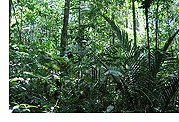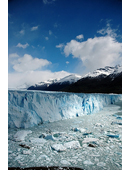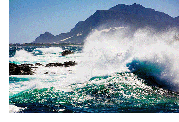|
||||||||||||||
| Forest,
Ice and Ocean Despite some guilt over many years of destroying the rain forests, polluting the oceans and melting the ice caps we have become desensitised in our increasingly “sound bite” driven world. The climate however is now set to restore priorities and give new perspectives. Biodiversity is important, but forests and oceans as carbon sinks suddenly have a different relevance. Icecaps melting may seem remote but if the impact is on sea level or on released carbon dioxide or even methane (worse greenhouse gas than CO2) then it is somehow more easily appreciated.  Forests:
Forests of various types are important biomes
covering about a third of the land. Three main types are found reflecting
different temperatures and rainfall. Boreal
forest (Taiga) forms the largest land biome
and circles the northern hemisphere, classically the evergreen forests of
Canada. Deciduous forest becomes more prevalent further south and includes
e.g. much of Europe’s forest. Tropical (rainforest) occupies the more
equatorial zones and perhaps receives the greatest media coverage having
the richest ecology, with new species still being discovered. Forests:
Forests of various types are important biomes
covering about a third of the land. Three main types are found reflecting
different temperatures and rainfall. Boreal
forest (Taiga) forms the largest land biome
and circles the northern hemisphere, classically the evergreen forests of
Canada. Deciduous forest becomes more prevalent further south and includes
e.g. much of Europe’s forest. Tropical (rainforest) occupies the more
equatorial zones and perhaps receives the greatest media coverage having
the richest ecology, with new species still being discovered. Apart from the obvious variety of trees, forest biomes are complex systems involving many other species from mammals to fungi. Destroying or indeed creating forests thus has significant wider impact. At a planetary level, forests act as a major carbon sink through photosynthesis. Physically they also alter the earth’s albedo and thus further impact on climate, and when removed or planted, alter the impact of weather on land. Deforestation obviously removes the potential to act as carbon sink. Frequently, where clearance is for crops, it relies on burning which adds to the CO2 and removes entire ecosystems and habitat for other species. Given the complex relationships between forest and planet overall, it is clear that reforestation or afforestation is not automatically beneficial especially when e.g. evergreen replaces deciduous forest; albedo, carbon uptake and ecology are all affected.  Ice:
Whilst we tend to focus on the polar ice-caps, the cryosphere
includes all the areas of snow, permafrost,
glaciers, freshwater and sea ice and forms a huge fraction of the earth’s
surface. Glaciers alone account for about 10% and seasonal snow as much
as a third of the land surface. Like forest, the cryosphere has a major
impact on the albedo of the earth and therefore the temperature. Furthermore
as ice, snow and permafrost, water is much less mobile and therefore does
not contribute to e.g. sea level. Also, it is now known that carbon dioxide
and methane are both “locked” in areas of the cryosphere, indeed
much of the planet’s freshwater is “locked” within e.g
. Antarctica. Ice:
Whilst we tend to focus on the polar ice-caps, the cryosphere
includes all the areas of snow, permafrost,
glaciers, freshwater and sea ice and forms a huge fraction of the earth’s
surface. Glaciers alone account for about 10% and seasonal snow as much
as a third of the land surface. Like forest, the cryosphere has a major
impact on the albedo of the earth and therefore the temperature. Furthermore
as ice, snow and permafrost, water is much less mobile and therefore does
not contribute to e.g. sea level. Also, it is now known that carbon dioxide
and methane are both “locked” in areas of the cryosphere, indeed
much of the planet’s freshwater is “locked” within e.g
. Antarctica.Put simply, altering the temperature of the planet will therefore impact hugely not only on sea level, it will disturb the planetary equilibria in ways we cannot anticipate since some positive feedback may occur e.g. increased CO2 causing increased temperature causing increased melting of ice which releases further CO2 and/or methane. Our appreciation of ice and snow melting in a UK context however does not help to appreciate the scale of the cryosphere or its susceptibility to climate change. The ice sheet in Antarctica holds 90% of the world’s ice and is up to 5km thick! Global warming will not simply melt this; indeed impact will not penetrate significantly at all. Nevertheless, even small impacts can cause significant rise in sea level and on greenhouse gas release. Moreover, impact on the Arctic appears to have been more significant with Arctic sea ice decreasing at about 3% per decade since 1978. Finally, and not least through relationship with the oceans, melting at either of the ice caps will have impact on weather, sea currents and storms.  Ocean:
Covering 70% of the earth’s surface, it is little wonder that oceans
have such a significant impact on weather sometimes at a catastrophic level
e.g. the El Niño (or La
Niña) impact on the US or drought in Ethiopia arising from
unusually warm waters in the tropical Pacific. Ocean:
Covering 70% of the earth’s surface, it is little wonder that oceans
have such a significant impact on weather sometimes at a catastrophic level
e.g. the El Niño (or La
Niña) impact on the US or drought in Ethiopia arising from
unusually warm waters in the tropical Pacific.The oceans act as a carbon sink but they also act as a thermal sink and a dynamic delivery system for that heat towards the poles and through the water cycle for precipitation around the planet. Influence of rainfall includes the opportunity for reduced rainfall and thus drought and so impacts at both extremes in different regions from flooding in Bangladesh to drought in Amazonian Brazil. The oceans like the forest biomes offer a rich ecological mix, but are more important as a source of food for many nations and thus have very direct impact through effects on fish stocks. Climate change can further affect these through altered salinity as well as temperature with clear significance for human geography as well as weather. The relationship between oceans and climate are most obvious through ocean currents e.g. the UK and Europe affected by the North Atlantic Drift (essentially a continuation of the Gulf Stream). Salinity and temperature both impact on ocean currents through the thermohaline circulation (Meridional circulation), and thus on the global cycling of water in the oceans, hence once again we see the complications of feedback. The oceans represent the largest active carbon sink and this function involves the surface, the deeper waters, and the interface between the two: the pyncnoline. Processes include both chemical and biological sinking. The chemical process is based on the solubility of CO2 in water whilst the biological process reflects a number of processes but in particular photosynthesis, particularly in phytoplankton. Other mechanisms can include the movement of trapped carbon between the surface, deeper waters and the sea bed. |
Forest: Ice: Ocean: |
|||||